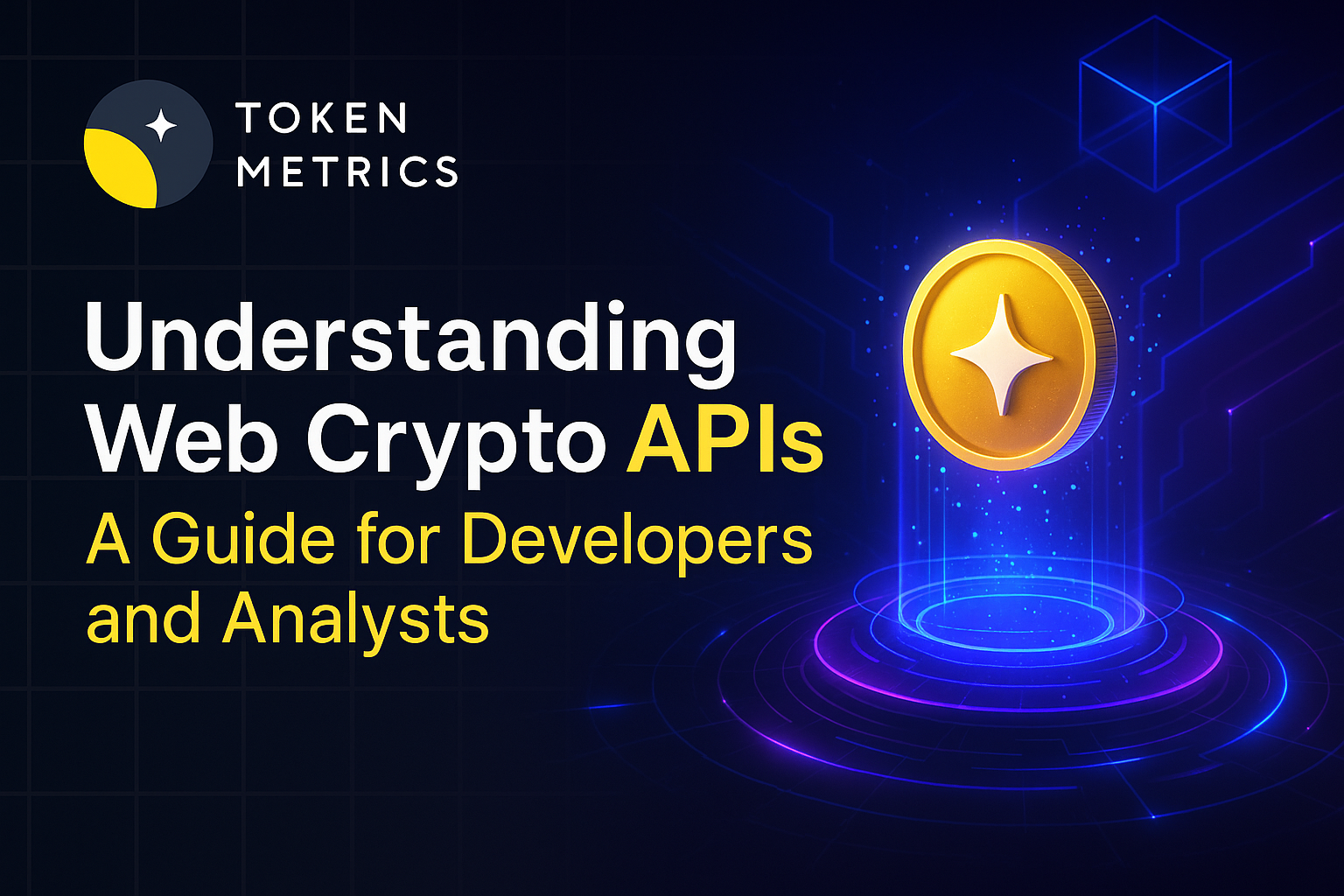
Understanding Web Crypto APIs: A Guide for Developers and Analysts

Introduction to Web Crypto APIs
In the evolving landscape of blockchain technology and cryptocurrency, web crypto APIs have become vital tools for developers, analysts, and businesses seeking to interact with decentralized networks and crypto market data. A web crypto API acts as an intermediary that enables applications to communicate with blockchain data, execute transactions, and retrieve real-time analytics seamlessly.
This guide explores core concepts behind web crypto APIs, common use cases, important technical considerations, and how AI-driven platforms, including Token Metrics API, contribute to comprehensive crypto data analysis for informed decision-making.
What Is a Web Crypto API?
A web crypto API is an application programming interface designed specifically to facilitate interaction between a web application and cryptocurrency networks or market data sources. It abstracts complex blockchain operations into manageable function calls developers can use to access wallets, process transactions, fetch token information, and obtain live or historical price data.
Types of web crypto APIs include those serving:
- Market Data Access: Retrieving pricing, volumes, exchange rates, and market capitalization.
- Blockchain Node Interaction: Sending and receiving transactions, querying blockchain states.
- Wallet Management: Creating or managing wallet addresses, signing transactions securely.
- Analytics and Ratings: Offering performance metrics, risk assessments, and AI-based token ratings.
With the rise of decentralized finance (DeFi), these APIs have expanded to include smart contract calls and decentralized exchange functionalities, enhancing their versatility.
Key Features of Leading Crypto APIs
When selecting or understanding a top crypto API, consider several critical features:
- Reliability and Uptime: Due to the high volatility and 24/7 nature of crypto markets, APIs must offer uninterrupted access and minimal downtime.
- Comprehensive Market Coverage: Support for multiple exchanges, diverse tokens, and various blockchain protocols enhances the value of the API.
- Historical and Real-Time Data: Both historical trends and current market movements are essential for in-depth analysis.
- Security Compliance: Handling sensitive wallet information or transaction signing requires strict adherence to security standards.
- Ease of Integration: Well-documented endpoints, SDKs, and support ease integration into web applications.
Leading solutions like the Token Metrics API exemplify these qualities, pairing market data access with AI-driven research capabilities.
Common Use Cases for Web Crypto APIs
Web crypto APIs have diverse applications across the crypto ecosystem. Notable use cases include:
- Portfolio Tracking and Analytics: Users and platforms employ APIs to fetch live token prices, holdings, and historical performance to monitor portfolio health.
- Algorithmic and Automated Trading: By integrating APIs into automated trading strategies, developers can react to market conditions programmatically on a crypto trading platform.
- DeFi Platforms: APIs facilitate lending, borrowing, swapping, and yield farming by connecting user interfaces with underlying smart contracts.
- Crypto Market Research: Analysts rely on APIs providing AI-generated ratings and token insights, for instance, via Token Metrics data, to evaluate project fundamentals.
- Wallet and Payment Solutions: APIs enable smooth transaction execution and wallet management within web apps.
Integrating Web Crypto APIs: Technical Considerations
Developers aiming to incorporate crypto APIs into web applications should consider the following technical aspects:
- Authentication and API Keys: Secure authentication mechanisms prevent unauthorized access. Store API keys securely and apply role-based permissions when available.
- Rate Limits and Usage Quotas: Understand API rate limits, implementing graceful handling of throttling or fallback strategies to maintain stability.
- Data Normalization: Different exchanges or blockchains may represent data distinctly; standardizing formats ensures consistent application behavior.
- Error Handling: Robust error detection and retry logic improve resilience against network disruptions or API failures.
- WebSocket vs. REST APIs: For real-time feeds, WebSocket protocols may be preferred; REST APIs suit on-demand query loads.
Choosing a provider like the Token Metrics API ensures access to well-structured endpoints and comprehensive documentation.
How AI Enhances Crypto API Analysis
Beyond raw data access, integrating AI models alongside crypto APIs enriches analytical insights. Platforms such as Token Metrics leverage machine learning to generate token ratings based on deep fundamental and technical analysis, helping users prioritize research focuses objectively.
Benefits of AI integration include:
- Advanced Pattern Recognition: Identifying market signals that are often imperceptible to human analysts.
- Risk Assessment: Quantifying potential downside risks based on historical volatility and on-chain metrics.
- Sentiment Analysis: Aggregating social and news data related to cryptocurrencies for trend triangulation.
- Automation of Repetitive Tasks: Reducing manual data processing time through algorithmic workflows.
Combining a dependable crypto API with AI-powered platforms offers a robust toolkit for comprehensive crypto market research and development.
Evaluating Web Crypto APIs: Best Practices
When selecting a web crypto API for your project or analysis, consider applying these best practices:
- Define Specific Needs: Clarify whether you require market data, wallet functions, blockchain queries, or all combined.
- Test API Reliability: Use trial accounts or sandbox environments to assess uptime and data accuracy.
- Review Security Policies: Confirm compliance with encryption standards and data privacy regulations.
- Analyze Cost vs. Benefits: Some APIs offer freemium tiers; evaluate if paid plans offer critical additional features.
- Consult Community and Developer Feedback: Insights from other users can reveal hidden challenges or advantages.
Leading providers such as Token Metrics API maintain transparent service specifications making evaluations easier.
Conclusion
Web crypto APIs represent foundational technology enabling seamless integration between web applications and the complex world of cryptocurrency markets and blockchains. By providing real-time and historical data, transaction capabilities, and increasingly incorporating AI-driven analytics from platforms like Token Metrics, these APIs empower developers and analysts to build innovative, data-informed solutions.
As crypto ecosystems expand, understanding and effectively leveraging web crypto APIs will continue to be essential for anyone involved in crypto technology development or market research.
Disclaimer
This blog post is for educational purposes only and does not constitute financial, investment, or trading advice. Always conduct your own research and consult professionals before making decisions related to cryptocurrencies.

.svg)

Create Your Free Token Metrics Account

.png)




%201.svg)
%201.svg)


%201.svg)































.svg)




.png)